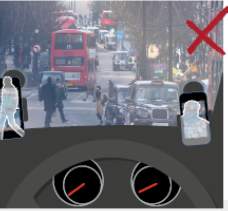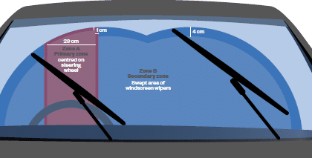Section 7: Learning materials
Section 7 – Safer Driving
PHV drivers need to keep a careful watch on the roads at all times and be able to interact safely with all other road users, especially those that are more vulnerable such as pedestrians, cyclists and motorcyclists.
This section tells you about the how to maintain the highest standards of driving. More advice on driving safely is on the TfL website.
1. Obey the law
As a PHV driver, you are expected to be fully aware of and to obey the rules of the road, as explained in The Highway Code. You should avoid behaviour that causes any danger to you, your passengers and other road users.
Most collisions in London are caused by a small number of easy-to-avoid behaviours. These include:
- Speeding or driving too fast for the conditions
- Making dangerous manoeuvres
- Getting distracted
- Not following the rules of the road
You need to be aware of your responsibilities as a professional driver and think about the topics in the sections below.
Safe speeds
Drive at a speed within the speed limit and one that is appropriate for the situation, environment and weather conditions.
The faster you drive, the less time you have to do something to avoid a collision. The resulting injuries also become more serious as speed increases.
Safe manoeuvres
Think about the manoeuvres you make, and make sure they are safe. This includes things like looking carefully when pulling out of junctions, turning across traffic or passing cyclists or motorcyclists.
Careless or dangerous driving is a serious offence with heavy penalties.
Concentration
You need to focus on the road and be able to react quickly. Don’t get distracted by mobile phones and other electronic devices, music or passengers.
If you do need to answer or make a call you will need to stop safely, park your vehicle and turn the engine off.
Distractions can make you less aware of what is happening on the road, and affect your judgement so your decision making abilities are reduced.
Remember it is also illegal to use a hand-held phone or similar device when you are driving unless you are calling the emergency services in an emergency and it is unsafe or impractical to stop. This includes when you are stopped in a queue of traffic e.g. at traffic lights, delays, etc.
Use of alcohol or drugs
You must never drive while you are under the influence of drugs or alcohol.
The police test for drug and alcohol use at the roadside to catch those who break the law.
Prescription medicine
If you are taking prescription medicine you must check with your doctor that it is safe for you to drive.
Following traffic laws before a journey begins
You need to know about and follow the laws on the safe use of vehicles e.g. laws that require you to have insurance, a current MOT certificate, a driving licence, wear a seatbelt and not drive a faulty vehicle.
All drivers must make sure that their vehicle is maintained to the required standard.
It is important that you are aware of the rules regarding passengers wearing seatbelts in PHVs.
All adults must wear a seat belt and drivers should encourage adult passengers to wear a seatbelt for their own safety. Drivers must also make sure that all children are correctly seated and restrained.
Remember
Drivers are responsible for making sure that all children under 14 years of age wear seatbelts or sit in an approved child car seat.
If the correct child car seat is not available, children can travel without one – but only if they travel on a rear seat:
* and wear an adult seat belt if they are 3 or older
* without a seat belt if they are under 3
The police keep a close watch on London’s roads 24 hours a day and will identify drivers who choose to break the law.
If you fail to obey any of the above rules, you may get a fixed penalty notice (FPN) or be prosecuted – this can result in a fine and penalty points on your licence. It may also result in you being banned from driving. You could also lose your PHV driver’s licence.
Being aware of other road users
TfL expects all professional drivers to be fully aware of other road users. In particular those people who are the most vulnerable:
Pedestrians: Be aware of pedestrians suddenly stepping into the road and give way to pedestrians on side roads.
Motorcyclists: Be aware of motorcyclists at all times but especially when you are turning or in slow moving traffic.
Cyclists: Be aware of cyclists at all times but especially when you are turning, in slow moving traffic or when you are pulling away from traffic lights. Make sure you give cyclists enough room when you overtake them
Please ask your passengers to check before they open their door into the road to make sure there isn’t a cyclist coming. You must do the same.
2. Windscreen vision
In clear sight
Annex 6 of the Highway Code, which deals with vehicle maintenance, says ‘Windscreens and windows must be kept clean and free from obstructions to vision’. That means you should not put or fix anything onto your windscreen that will stop you being able to see the road ahead. This includes mobile phones, sat navs and other devices that will reduce your vision:
These pictures, based on photographs taken by the City of London
Police, show just how much your area of vision is reduced by having
devices attached to your windscreen.



Be cradle careful
Before starting any journey, you should make sure you have a clear view through the windscreen and windows of your vehicle and that no devices or signage reduce or obstruct your view.
If you put a cradled device (such as a mobile phone or sat nav) on the area on your windscreen that is covered by your windscreen wipers (known as the ‘swept area’), you are committing an offence. If you are prosecuted, you may be fined and get penalty points on your driving licence.
Driving conditions can change quickly and dangers such as pedestrians suddenly stepping in front of you, or bikes coming out of side streets, mean you need to have a clear view of the road. If your windscreen is covered in devices, you increase your chances of getting distracted or not seeing dangers in time to avoid them. You must make sure that you put any devices in positions that do not reduce how much you can see.

The swept area of a windscreen
3. Other things to consider
Being tired: Tiredness can have a similar effect on a driver as drinking alcohol, and can result in death or serious injury. Plan your day to include regular breaks from driving and do not begin a journey if you are already tired.
Weather conditions: You should change your driving behaviour when the weather conditions change, so that you are always driving safely. If it suddenly starts to rain heavily or there is thick fog, reduce your speed.
Driving at night: You should pay particular attention when driving at night because pedestrians, cyclists and motorcyclists may be more difficult to see then.
4. Cycle safety
Cycle safety
PHV drivers spend a lot of time on the roads and are almost twice as likely as private car drivers to be involved in a collision that results in the death or serious injury of a cyclist. Because of this, it is very important that you follow the advice below so you can reduce the risk of a collision and help make sure that everyone travels safely.
Top tips:
- Always check for cyclists, pedestrians and motorcyclists who may be moving, even if most vehicles are stopped in traffic.
- Look out for cyclists, especially when checking your mirrors before indicating to go left or right, or changing your speed or direction.
- Check over your shoulder for cyclists and other road users before opening your door to make sure it doesn’t swing out in front of them.
- Use your indicators when turning or changing lanes, even if you don’t think anyone is near you
- Indicate well in advance to allow others to react.
- Make sure your indicator is off once you have completed your manoeuvre, to avoid confusing cyclists and other road users.
Give cyclists room
Keep a safe distance from cyclists and don’t try to overtake when there is not enough space. Give as much space as you would for another car. If a cyclist is using the middle of the lane, wait patiently until you can pass safely.

This space is for cyclists and you may be fined and get points on your driving licence.
Leave room for cyclists at traffic lights. Drivers should not enter the advanced stop line box when the light is red.
5. Vehicle safety
As a professional driver you are responsible for checking your vehicle is safe and legal to drive.
Driver’s compartment
For example, in the driver’s compartment you should check that the horn works.
Other things to check include:
- Your seat and seatbelt are in good condition, are secure and you can adjust them as you need
- The steering wheel is secure and in good condition
- The clutch and brake pedals have anti-slip covers
- The handbrake is in good working condition Driver warning lights do not light up when the engine is started
- The indicators are working correctly
- The windscreen washers and wipers are in good condition
- Any devices for opening and closing the driver and front passenger windows work correctly You can see in all the mirrors
- You can see all the mirrors
Passenger compartment
This should be clean and all equipment in it must be in good working order, such as the seat belts fitted to the passenger seats.
This also includes:
- Upholstery, headlining, carpets and door trims
- Passenger courtesy lights
- Wheelchair safety belts/seat belts (if applicable)
- All doors and door locking mechanisms
- Vehicle heater system
- No smoking signs
- CCTV signage is displayed in a prominent position (this is only required where CCTV is installed in the vehicle)
Wheels and tyres
Tyres must be the correct size, speed and weight rating for the make and model of your vehicle. You should make sure all wheel nuts are in place and secure.
Tyres must be free from:
Cuts, lumps, bulges and tears
Excessive or uneven tyre wear
Excessive damage to the wheel rim
Tyre wear bar indicators are positioned around the tyre. If the tread pattern has worn down to the level of the indicators, then you must replace the tyre.
Outside the vehicle
Make sure there are no signs of fluids (oil, brake fluid) leaking from under the vehicle on to the ground.
You should check:
- All external lights and reflectors are there and secure, undamaged and working
- Body panels have not been badly repaired
- There is no evidence of serious damage to the external body panels
- There is no serious rusting or corrosion resulting in sharp edges
- All windows are clean, undamaged and free from unapproved signage or advertising material